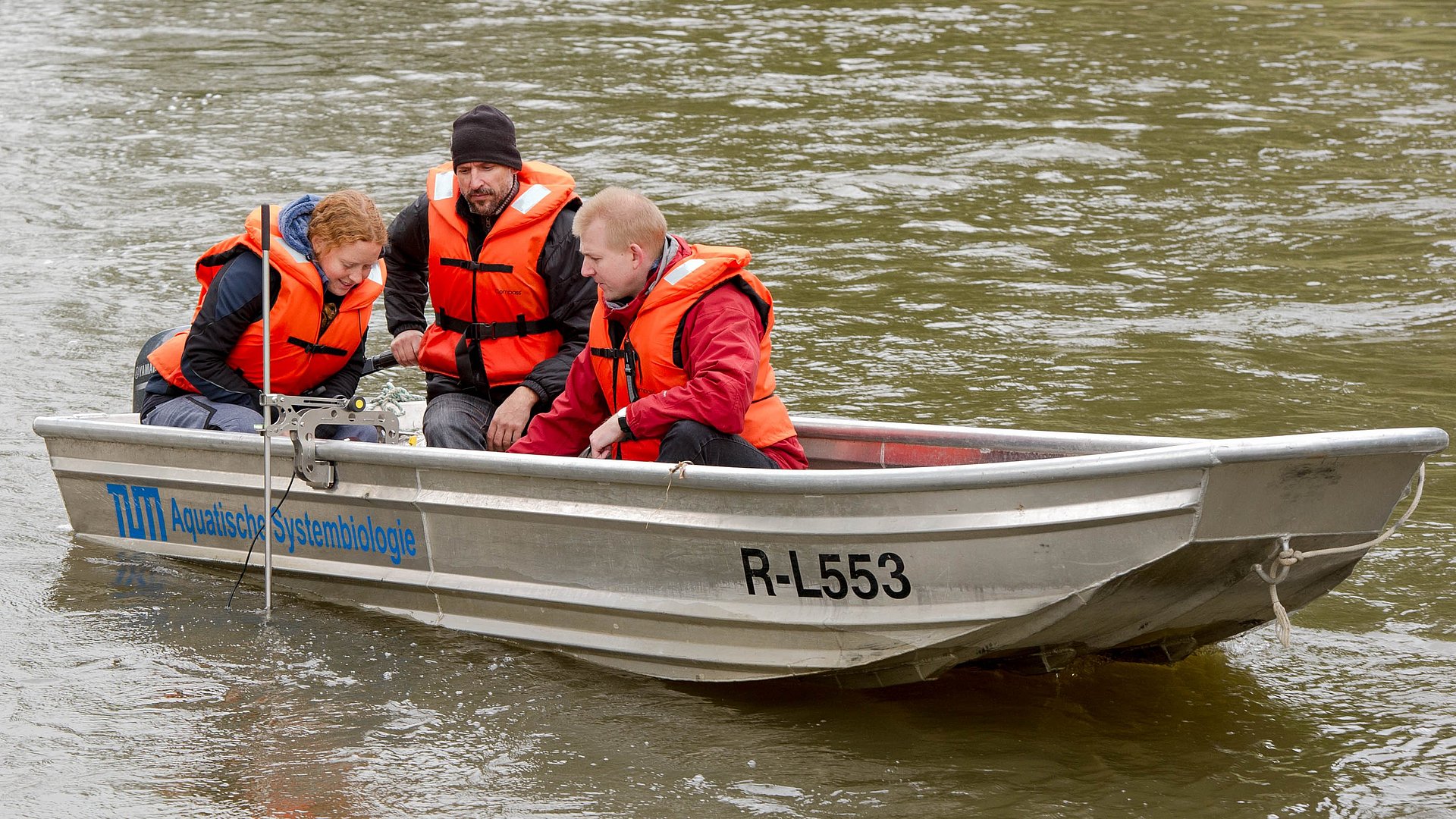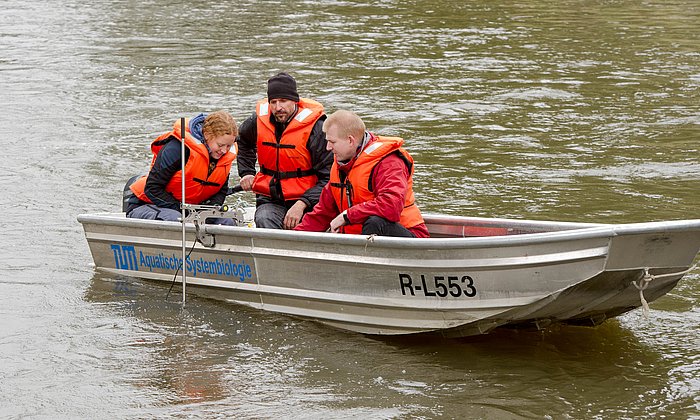Examining the environmental impacts of the Großweil shaft power plant
“Making hydropower plants more environmentally friendly”

Developed in recent years, the shaft power plant is a novel type of hydropower installation. A shaft housing the turbine and generator is installed in the riverbed upstream of a weir. Water flows into the shaft, drives the turbine and is then directed back into the river by the weir. A smaller proportion of the water flows over the shaft and the weir. The weir features openings, which are designed to allow fish to migrate downstream. This design aims to ensure that, unlike in other types of hydropower plant, only a small number of fish are harmed by traveling into the turbine. Conventional fish ladders also allow fish to migrate upstream.
It is a concept developed by water resource engineers at TUM. A spin-off company has acquired usage rights for the concept and awarded licenses to power plant operators. These include the constructor and operator of the plant in Großweil, Bavaria, where a team from the TUM Chair of Aquatic Systems Biology has now conducted research. Their findings on the plant’s environmental impact have been published in the Renewable and Sustainable Energy Reviews.
Standardized test procedures
In their investigation into the environmental situation at the shaft power plant in the Loisach, the research team followed a standardized procedure in releasing several thousand fish from eight species typical to Bavaria upstream from the hydropower plant. After the fish passed the installation, they were captured in large nets stretched across the watercourse, along with wild fish also living in the river. The researchers then examined the fish for signs of injury, including taking X-ray images to check for internal injuries. They also deployed sensors to examine the forces to which the fish are subjected when passing the power plant.
Only 21% of the fish released upstream and recaptured downstream from the power plant passed through the openings in the weir, while 75% traveled through the turbine shaft. The remaining 4% used the lateral fish ladders. The grill – a grate covering the shaft – allowed larger fish to pass through than had been thought possible (longer than 30 centimeters). The median mortality rate for all species of fish that passed the turbine was 13%. The highest mortality rate of 44% was recorded for roach while the turbine was subject to low load. The lowest mortality rate of less than 1% was recorded for grayling and brown trout while the turbine was subject to high load. A significant number of other fish were also injured. Of the wild fish captured during the study, 47% passed through the openings in the weir, 35% through the shaft and 18% via the fish ladder.
Factors for improvement
The research team identified a number of factors for consideration in the construction and operation of future shaft power plants to minimize the risks to fish.
- In keeping with the scientific concept for the power plant, it is important to maintain a sufficient flow of water through the openings in the weir. Larger openings and, in some cases, additional openings in the weir would make it easier for fish to migrate downstream.
- The gaps between the bars in the grill should be less than 20 millimeters. It is also important to repair damage to the grill on a regular basis to minimize the number of fish that enter the shaft.
- The turbine should be of a type that incurs lesser impact than the Kaplan turbine used in Großweil. If this is not possible, the turbine should not be operated at a low load, as this harmed more fish than when operating under full load.
- The downstream area into which the fish emerge after passing through the openings in the weir should be designed to eliminate any risk of injury. This includes, for example, ensuring that the water the fish land in is always of sufficient depth to provide a cushioning effect.
- The inlet into the shaft should be flush with the riverbed.
Altered conditions in the river
The research team has also analyzed changes in the aquatic habitat caused by the installation of the hydropower plant in the Loisach. The researchers worked upstream and downstream of the existing weir both before and after the plant’s construction, examining fish, small invertebrate aquatic organisms, aquatic plants and algae along with environmental factors including the water temperature, oxygen level and pH value.
The hydropower plant’s construction increased the river’s depth above the weir and reduced the flow rate. This led to a deterioration in the habitat conditions for species typically found in running waters. In particular, a reduction in oxygen-rich water exchange in the so-called interstitial gravel ecosystem in the riverbed – which provides a vital habitat for many organisms – led to a reduction in the prevalence of small aquatic organisms.
“Careful analysis of all factors is crucial”
The study of the shaft power plant was part of a large-scale research project in which the team analyzed eight hydropower plants of five different types, including several novel concepts. The majority of the findings have been published last year.
The project has shown that it is rarely possible to make general, sweeping statements about which type of type of hydropower plant is most environmentally friendly. Instead, the scale of ecological impact depends on the specific body of water, the species of fish that live there and the technological components used, such as the turbine type, the overall design and the operating mode.
“Our insights demonstrate the need for a more differentiated approach in the construction and renovation of hydropower plants in the future. Careful analysis of all factors is crucial in keeping the damage to the ecosystem to a minimum,” says Prof. Jürgen Geist, who led the study. “While new opportunities deserve an opportunity, they must stand up to comparison in practice. We have discussed specific improvements for the power plants we examined, some of which are already underway.”
Knott J, Mueller M, Pander J, Geist J (2023), Ecological assessment of the world's first shaft hydropower plant. Renewable and Sustainable Energy Reviews. DOI: 10.1016/j.rser.2023.113727
Mueller M, Knott J, Pander J, Geist J (2022), Experimental comparison of fish mortality and injuries at innovative and conventional small hydropower plants. Journal of Applied Ecology. DOI: 10.1111/1365-2664.142
The research project – called “Fish-ecological monitoring at innovative hydropower plants ” – was commissioned and financed by the Bavarian State Ministry of the Environment and Consumer Protection. It was supported by the Bavarian State Office for the Environment (LfU). (German website)
Contacts to this article:
Prof. Dr. Jürgen Geist
Technical University of Munich
Chair of Aquatic Systems Biology
Tel.: +49 8161 71 3767
geist@tum.de
